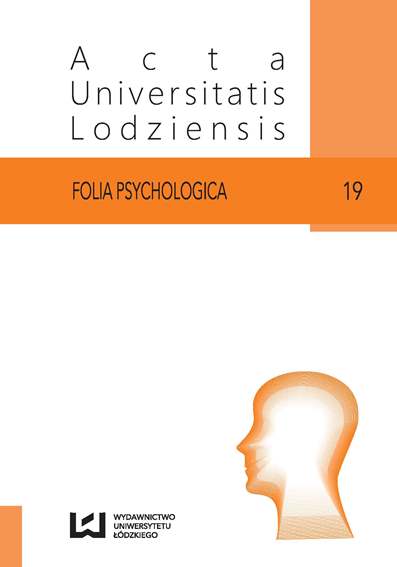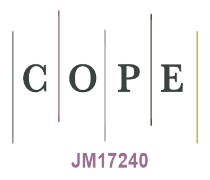Analiza podatności na złudzenia wzrokowe ze względu na zależność od pola i płeć
DOI:
https://doi.org/10.18778/1427-969X.19.02Słowa kluczowe:
złudzenia kształtu i kierunku, teoria stałości przechylenia, FDI, Zӧllner i Poggendorff, iluzja Pręta i RamyAbstrakt
Poszukiwano odpowiedzi na pytania: czy osoby ulegające złudzeniom kształtu i kierunku ulegają także złudzeniom stałości przechylenia; czy osoby zależne w porównaniu z niezależnymi od pola w ujęciu Witkina charakteryzuje większa podatność na złudzenia; czy kobiety bardziej niż mężczyźni ulegają złudzeniom wzrokowym? Przeprowadzono dwa badania. W pierwszym wzięło udział 75 uczniów (M = 18,5; SD = 0,5), zaś w drugim 31 studentów psychologii (M = 20; SD = 0,5). Zastosowano Rod and Frame Test do badania iluzji Pręta i Ramy, komputerową symulację złudzeń wzrokowych: Zollnera, Poggendorffa, Ponzo, Ebbinghausa, Millera-Lyera oraz EFT Witkina do określania zależności od pola. Okazało się, że kobiety bardziej niż mężczyźni ulegają iluzji Pręta i Ramy, Poggendorffa i Zӧllnera, natomiast zależność od pola nie różnicuje podatności na badane złudzenia. Związki pomiędzy iluzją Pręta i Ramy a pozostałymi złudzeniami uzyskano dla kąta odchylenia ramy od pionu o 15 stopni.
Bibliografia
Aglioti S., DeSouza J. F. X., Goodale M. A. (1995). Size-contrast illusions deceive the eye but not the hand. Current Biology, 5 (6), 679–685.
Google Scholar
DOI: https://doi.org/10.1016/S0960-9822(95)00133-3
Asch S. E., Witkin H. A. (1948a). Studies in space orientation: I. Perception of the upright with displaced visual fields. Journal of Experimental Psychology, 38 (3), 325–337.
Google Scholar
DOI: https://doi.org/10.1037/h0057855
Asch S. E., Witkin H. A. (1948b). Studies in space orientation: II. Perception of the upright with displaced visual fields and with body tilted. Journal of Experimental Psychology, 38 (4), 455–475.
Google Scholar
DOI: https://doi.org/10.1037/h0054121
Bednarek H. (2011). Czy piloci ulegają złudzeniom percepcyjnym? Poznawcze uwarunkowania dezorientacji przestrzennej. Sopot: Gdańskie Wydawnictwo Psychologiczne.
Google Scholar
Bolouki S., Grosse R., Lee H., Ng A. (2007). Optical Illusion. Standford University, Stanford.
Google Scholar
Changizi M. A., Widders D. M. (2002). Latency correction explains the classical geometrical illusions. Perception, 31, 1241–1262.
Google Scholar
DOI: https://doi.org/10.1068/p3412
Coren S., Girgus J. S., Erlichman H., Hakstian A. R. (1976). An empirical taxonomy of visual illusions, Perception and Psychophysics, 20 (2), 129–137.
Google Scholar
DOI: https://doi.org/10.3758/BF03199444
Gibson J. J. (1937). Adaptation, after-effect, and contrast in the perception of tilted lines: II. Simultaneous contrast and the areal restriction of the after-effect. Journal of Experimental Psychology, 20 (6), 553–569.
Google Scholar
DOI: https://doi.org/10.1037/h0057585
Gibson J. J. (1979). The Ecological Approach to Visual Perception. Boston: Houghton Mifflin.
Google Scholar
Ginsburg A. P. (1984). Visual form perception based on biological filtering. W: I. Kohler, L. Spillmann, B. R. Wotten (red.), Sensory Experience, Adaptation and Perception (s. 53–72). Hillsdale: L. Erlbaum Associates.
Google Scholar
Girgus J. S., Coren S. (1982). Assimilation and contrast illusions: Differences in plasticity. Perception and Psychophysics, 32 (6), 555–561.
Google Scholar
DOI: https://doi.org/10.3758/BF03204210
Gregory R. L. (1971). Oko i mózg. Psychologia widzenia. Przekł. S. Bogusławski. Warszawa: PWN.
Google Scholar
Gregory R. L. (1997). Knowledge in perception and illusion. Philosophical Transactions of the Royal Society of London. Series B, Biological Sciences, 352 (1358), 1121–1127.
Google Scholar
DOI: https://doi.org/10.1098/rstb.1997.0095
Gregory R. L. (2005). The Medawar Lecture 2001. Knowledge for vision: vision for knowledge. Philosophical Transactions of the Royal Society of London. Series B, Biological Sciences, 360 (1458), 1231–1251.
Google Scholar
DOI: https://doi.org/10.1098/rstb.2005.1662
Huteau M. (1983). Zależność – niezależność od pola i rozwój myślenia operacyjnego. Przegląd Psychologiczny, 2, 253–286.
Google Scholar
Isableu B., Gueguen M., Fourré B., Giraudet G., Amorim M.A. (2008). Assessment of visual field dependence: Comparison between the mechanical 3D rod-and-frame test developed by Oltman in 1968 with a 2D computer-based wersion. Journal of Vestibular Research, 18, 239–247.
Google Scholar
DOI: https://doi.org/10.3233/VES-2008-185-601
Karmiloff-Smith A. (2007). Williams syndrome. Current Biology 17 (24): R1035–R1036.
Google Scholar
DOI: https://doi.org/10.1016/j.cub.2007.09.037
Kolańczyk A. (2011). Uwaga ekstensywna. Model ekstensywności vs. intensywności uwagi. Studia Psychologiczne, 49 (3), 7–27.
Google Scholar
DOI: https://doi.org/10.2478/v10167-010-0024-x
Kozhevnikov M. (2007). Cognitive styles in the context of modern psychology: Toward an integrated framework of cognitive style. Psychological Bulletin, 133 (3), 464–481.
Google Scholar
DOI: https://doi.org/10.1037/0033-2909.133.3.464
Króliczak G. (1999). Dwa mózgi wzrokowe: percepcja a wzrokowa kontrola działania. Kognitywistyka i Media w Edukacji, 199–223.
Google Scholar
Króliczak G. (2002). Czy iluzje zwodzą jedynie „oko”, ale już nie rękę? http://www.kognitywistyka.net/artykuly/gk-czizjolnr.pdf [dostęp: 16.02.2015].
Google Scholar
Künnapas T. M. (1955). Influence of frame size on apparent length of a line. Journal of Experimental Psychology, 50 (3), 168–170.
Google Scholar
DOI: https://doi.org/10.1037/h0044569
Ling J., Hamilton C., Heffernan T. M. (2006). Sex differences in the Poggendorff illusion: Identifying the locus of the effect. Perceptual and Motor Skills, 102, 142–146.
Google Scholar
DOI: https://doi.org/10.2466/pms.102.1.142-146
Lukas A. (2011). Zależność vs niezależność od pola a podatność na złudzenia wzrokowe i grawitacyjne. Niepublikowana praca magisterska, Uniwersytet Łódzki, Łódź.
Google Scholar
Maheux M. J., Townsend J. C., Gresock C. J. (1960). Geometrical factors in illusions of direction. The American Journal of Psychology, 73 (4), 535–543.
Google Scholar
DOI: https://doi.org/10.2307/1419941
Miller A. (1991). Personality types, learning styles, and educational goals. Educational Psychology, 11 (3–4), 217–238.
Google Scholar
DOI: https://doi.org/10.1080/0144341910110302
Milner A. D., Goodale M. A. (2008). Mózg wzrokowy w działaniu. Przekł. G. Króliczak. Warszawa: Wydawnictwo Naukowe PWN.
Google Scholar
Miyake A., Witzki A., Emerson M. (2001). Field dependence-independence from a working memory perspective: A Dual-task investigation of the Hidden Figures Test. Memory, 9, 445–457.
Google Scholar
DOI: https://doi.org/10.1080/09658210143000029
Młyniec A. (2013). Style poznawcze, sprawność funkcji uwagowo-pamięciowych a odporność na złudzenia wzrokowe w grupie architektów. Niepublikowana praca magisterska, Szkoła Wyższa Psychologii Społecznej, Warszawa.
Google Scholar
Ninio J. (2014). Geometrical illusions are not always where you think they are: A review of some classical and less classical illusions, and ways to describe them. Frontiers in Human Neuroscience, 8, 856–870.
Google Scholar
DOI: https://doi.org/10.3389/fnhum.2014.00856
Nosal C. S. (1990). Psychologiczne modele umysłu. Warszawa: PWN.
Google Scholar
Oyama T. (1977). Feature analysers, optical illusions, and figural aftereffects. Perception, 6 (4), 401–406.
Google Scholar
DOI: https://doi.org/10.1068/p060401
Prinzmetal W., Beck D. (2001). The tilt-constancy theory of visual illusions. Journal of Experimental Psychology. Human Perception And Performance, 27 (1), 206–217.
Google Scholar
DOI: https://doi.org/10.1037/0096-1523.27.1.206
Prinzmetal W., Shimamura A. P., Mikolinski M. (2001). The Ponzo Illusion and the perception of orientation. Perceptions and Psychophysics, 63 (1), 99–114.
Google Scholar
DOI: https://doi.org/10.3758/BF03200506
Porac C., Coren S., Girgus J. S., Verde M. (1979). Visualgeometric illusions: Uni-sexed phenomena. Perception, 8, 401–412.
Google Scholar
DOI: https://doi.org/10.1068/p080401
Robinson K. E. (2001). Intellectual biography of Herman Witkin and his theory of psychological differentiation. Doctoral dissertation, Carlos Albizu University.
Google Scholar
Rock I. (1984). Perception. New York: Scientific American Library.
Google Scholar
Smeets J. B., Brenner E. (2006). 10 years of illusions. Journal of Experimental Psychology. Human Perception and Performance, 32 (6), 1501–1504.
Google Scholar
DOI: https://doi.org/10.1037/0096-1523.32.6.1501
Witkin H. A., Oltman P. K., Raskin E., Karp S. A. (1971). A Manual for the Embedded Figures Tests. Palo Alto: Consulting Psychologist Press.
Google Scholar
DOI: https://doi.org/10.1037/t06471-000
Witkin H. A., Goodenough D. R. (1981). Cognitive style: essence and origins. New York: International Universitatis Press.
Google Scholar
Walter E. L. (2007). Visuospatial Contextual Processing: Illusions, Hidden Figures and Autistics Traits. Oregon: University of Oregon.
Google Scholar
Walter E., Dassonville P. (2008). Visuospatial contextual processing in the parietal cortex: An fMRI investigation of the induced Roelofs effect. Neuroimage, 42, 1686–1697.
Google Scholar
DOI: https://doi.org/10.1016/j.neuroimage.2008.06.016
Zhang L.-F. (2004). Field-dependence/independence: Cognitive style or perceptual ability? Validating against thinking styles and academic achievement. Personality and Individual Differences, 37 (6), 1295–1311.
Google Scholar
DOI: https://doi.org/10.1016/j.paid.2003.12.015
Zimbardo P. G., Johnson R. L., McCann V. (2010). Psychologia. Kluczowe koncepcje. Struktura i funkcje świadomości. Warszawa: Wydawnictwo Naukowe PWN.
Google Scholar
Zoccolotti P., Antonucci G., Goodenough D. R., Pizzamiglio L., Spinelli D. (1992). The role of frame size on vertical and horizontal observers in the rod-and-frame illusion, Acta Psychologica, 79 (2), 171–187.
Google Scholar
DOI: https://doi.org/10.1016/0001-6918(92)90031-8
Pobrania
Opublikowane
Jak cytować
Numer
Dział
Licencja
Prawa autorskie (c) 2015 © Copyright by Hanna Bednarek, Agnieszka Lukas, Łódź 2015; © Copyright for this edition by Uniwersytet Łódzki, Łódź 2015

Utwór dostępny jest na licencji Creative Commons Uznanie autorstwa – Użycie niekomercyjne – Bez utworów zależnych 4.0 Międzynarodowe.









